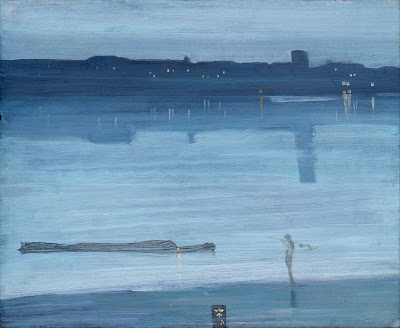Research INTO my Major Project
Artists inspired by music
There were many artists through the centuries that were inspired by music. Paul Klee’s, Piet Mondrian and Henri Matisse are some examples but the ones I did more research was James Abbott McNeill Whistler since he painted nocturnes that are believed to be inspired by Chopin’s Nocturnes, which includes the one that I chose to represent “Classical Music” in my Major Project; and Wassily Kadinsky, that created a whole new language inspired by music, in which sounds gain colours and shapes.James Whistler
James Whistler's Nocturnes are believed to be related to Chopin's compositions. The term "Nocturne" was normally applied to a certain type of musical composition, however after James Whistler (1834 - 1903) , who was inspired by the language of muic, the word began to be used in tittles of many of his works, such as Nocturne in Blue and Silver (1871). This term was used by James Whistler to represent paintings that were dreamy, pensive mood.
Even though this is a painting, in my point of view, as person who knows and likes Chopin's Nocturnes, it is clearly related to one another. Nocturnes have always a beautful sonority, most os the times almost like a dream. I often relate them to the sea and the moon, the lights of the city in the night and its reflections.
Wassily Kandinsky
Wassily Kandisky was born in the year 1866 in Moscow. In his early years, he learned to play piano and cello. Later, music would play a important tole in his art and life. Although he had studied economic policy, after visiting a French impressionist art exhibition in 1895, Kandinsky decided to become a painter. He studied not only the impressionist style but also the Art Noveau style. His first paintings were impressionistic, but soon his painting style changed to the abstract. Kandinsky was inspired by one of his friends - the composer Arnold Shoenberg - while searching for a complete new language of painting, which evolved anarchistic music, art and literature in a big mess.
While researching I found this video explaining in detail the process and like of Kandinsky, it is entitled "What does the colour sounds like?".
In order to support his colour theories, in which each sound had a correspondent colour, Kandinsky in his manifesto appealed to the evidence of synaesthesia, a condition in which the senses are confused with one another, for example someone may hear the ring of a doorbell as tasting of chicken.
Kandinsky dedicated his whole life trying to create a language universal in painting and music, and one of the most important part of his work is his colour study. According to his manifesto, sounds had different colours for example:
- Green is the most restful colour that exists, in music the absolute green is represented by "...the placid middle notes of a violin";
- White has the harmony of silence which works upon us negatively "like many pauses in music that break the melody";
- A total dead silence has the inner harmony of black, in music is represented by those "profound and final pauses". Black is the colour of least harmony at all;
- Light warm red is the sound of "trumpets - strong, harsh and ringing";
- Cool red - Madder is the "sad, middle tone of a cello";
- Orange's note is that of an "Angelus, or of an old violin";
- Violet is" an english horn, or the deep notes of a wood instruments";
- Blue is the heavenly colour "a light blut is like a flute", " a dark blue a cello", "darker is a thunderous double bass", "and the darkest blue of all, an organ".
Kandinsky defended that "colour is the keyboard, the eyes are the hammers, the soul is the piano with many strings. The artist is the hand which plays, touching one key or another, to cause vbrations in the soul"
Artsynet, How Music Motivated Artists from Matisse to Kandinsky to Reivent Painting[online] Available from: https://www.artsy.net/article/artsy-editorial-music-motivated-artists-matisse-kandinsky-reinvent-painting
Wikipedia, Nocturne (painting)[online] Available from: https://en.wikipedia.org/wiki/Nocturne_(painting)
The Guardian, Wassily Kandinsky: the painter of sound and vision[online] available from: https://www.theguardian.com/artanddesign/2006/jun/24/art.art
Jasmine Directory, Wassily Kandinsky - The painter of Music [online]Available from: https://www.jasminedirectory.com/blog/wassily-kandinsky-the-painter-of-music/



You need to critically discuss these artists works much more deeply - really look at how they have used colour, composition and light and really go into depth in regard to their methods to inform your own work
ReplyDelete